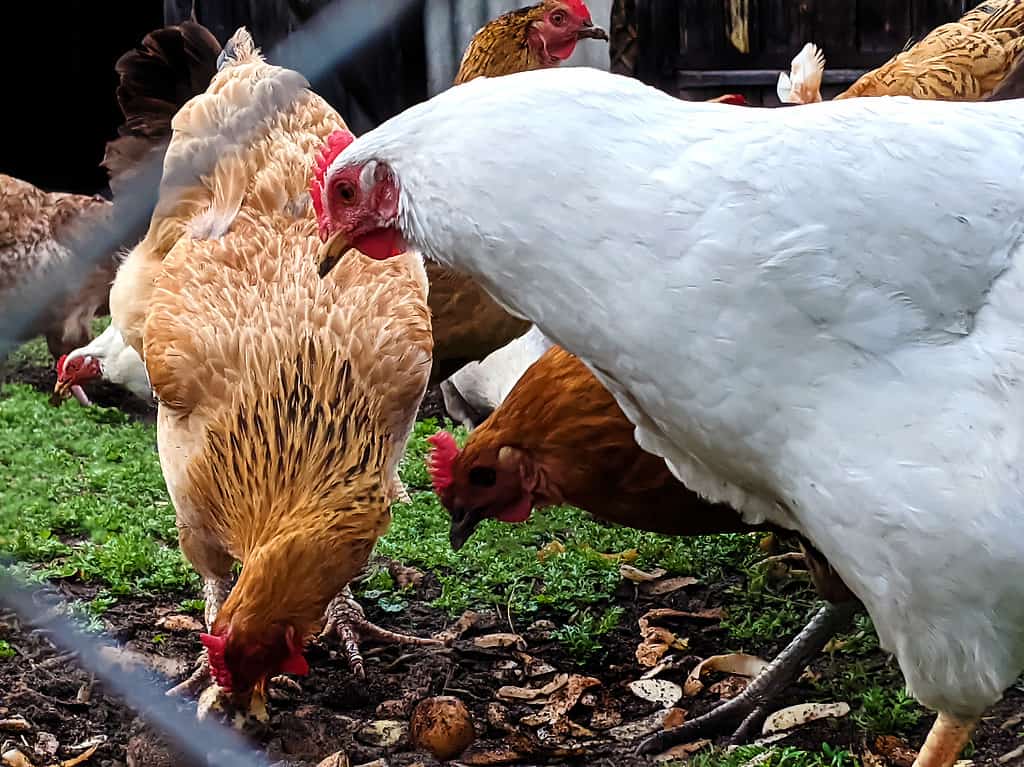Perhaps the rarest chicken breed in America is the Holland chicken. This meaty, hardy breed is known for being affable and friendly toward humans, making it a treasured backyard pet. It’s also an excellent dual-purpose chicken that turns out hundreds of eggs a year. Read on to find out the origins of this unique breed, its characteristics, price, and much more!
Holland Chicken Origin

Despite its name, the Holland chicken originated in New Jersey, USA.
©Bobtokyoharris/iStock via Getty Images
Holland chickens were initially bred in the mid-1930s because there was a growing demand for white eggs instead of brown. At the time, people believed white eggs were of higher quality and tasted better. Up until that point, however, fleshy dual-purpose chickens tended to lay brown eggs. Most chickens that laid white eggs were lightweight and, therefore, of limited use as a source of meat. Farmers wanted a dual-purpose chicken that could provide good-quality meat and white eggs; thus, the Holland breed was born.
Rutgers Breeding Farms in New Jersey was the first to breed Holland chickens. They came in two varieties: white and barred. White Hollands was a cross between lightweight chickens from Holland, Lamonas, New Hampshires, Rhode Island Reds, and White Leghorns. Barred Hollands were a cross between Australorps, Barred Plymouth Rocks, Brown Leghorns, and White Leghorns. The American Poultry Association Standard of Perfection accepted both varieties in 1949.
Today, Hollands of both varieties are rare. White Hollands may even have disappeared entirely. The Livestock Conservancy lists the breed status as Critical.
Holland Chicken Characteristics
Below are the characteristics of the Holland chicken, including varieties, size and weight, color and appearance, temperament, care, health, and lifespan.
Varieties

The Holland chicken comes in two varieties: barred and white.
©Jos Everts/iStock via Getty Images
Holland chickens come in two varieties: barred and white. Barred Hollands have always been more popular, resulting in the decline of the white varieties. White Hollands may now be extinct. Barred Hollands may have been preferred because white fowl are more visible against the ground, making them more susceptible to predators. Also, the Barred Plymouth Rock breed used to create the Barred Holland was popular with farmers. That said, both varieties make excellent backyard chickens.
Size and Weight
Holland chickens are relatively large with a muscular build. The typical Holland rooster weighs between six and 8.5 pounds. Holland hens are slightly smaller, averaging four to 6.5 pounds at maturity.
Color and Appearance
White Holland chickens are all white with red wattles and combs. Barred Hollands also have red combs and wattles but are much darker with a barred pattern. Females tend to be darker than males. Both varieties have clean yellow legs, pale yellow beaks, and red earlobes.
Temperament
Holland chickens are known for being friendly and approachable, which makes them great for families with young children. Unlike some fowl, they enjoy interacting with humans. In addition to making good pets, they are also ideal for farm life.
Care

Like other free-range chickens, Hollands enjoy ranging and foraging for food.
©Dmitriy Prokofev/iStock via Getty Images
Though they do not enjoy confinement, Holland chickens are low-maintenance and make excellent backyard fowl. As foragers, they can find much of their food. They are cold-tolerant, but they still require adequate shelter in adverse conditions. Males may develop frostbite on their combs in extreme cases. The bigger the comb, the more likely it is to develop frostbite.
Holland chicks will need to eat chick starters for the first 8-12 weeks, after which they can transition to a high-quality laying feed. Calcium supplements may be necessary if the hens lay eggs with brittle shells.
All chickens need a safe place to shelter at night to avoid predators. However, during the day, Hollands prefer to range.
Health and Lifespan
Holland chickens are generally a hardy, healthy breed with few health issues. They grow pretty slowly but turn out to be meaty and robust. The average individual lives about eight years.
Holland Chicken Eggs

The Holland chicken breed lays medium-large white eggs.
©Picture Partners/Shutterstock.com
Holland chickens exclusively lay white eggs, which they were bred to do. Their eggs are medium-large in size. The average hen lays 200-240 eggs per year. Hens often become broody, occasionally raising their young.
Holland Chicken Uses
Holland chickens are dual-purpose, meaning farmers raise them for meat and eggs. The breed tends to be meaty and muscular, which makes them ideal for the meat market. Naturally, their white-shelled eggs are also valuable. Alternately, some people keep Hollands as pets in their backyards.
Holland Chicken Price
Although prices vary, some breeders sell a Barred Holland chick for USD 15. You can expect to pay more for older and heavier chickens.
Summary Table of Holland Chicken Characteristics
| Characteristic | Description |
|---|---|
| Varieties | Barred and White |
| Size | Medium-large |
| Weight | Males: 6-8.5 lbs Females: 4-6.5 lbs |
| Color/Appearance | Generally healthy and robust Lifespan of approximately eight years |
| Temperament | Friendly, docile, approachable, cheerful |
| Care | Hardy and cold-tolerant |
| Health/Lifespan | Generally healthy and robust Lifespan of approximately 8 years |
| Number of Eggs Annually | 200-240 |
| Egg Size | Medium-large |
| Egg Color | White |
The photo featured at the top of this post is © Jos Everts/iStock via Getty Images
Thank you for reading! Have some feedback for us? Contact the AZ Animals editorial team.







